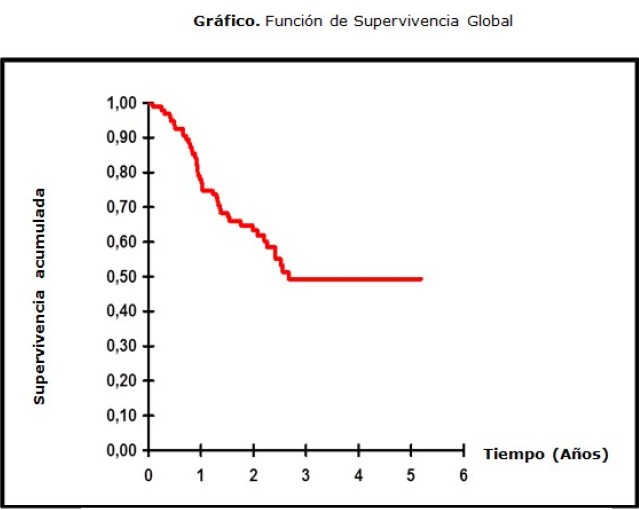Radioterapia en el adulto mayor con carcinoma avanzado de cabeza y cuello
Texto completo:
PDF
Resumen
Fundamento: en el paciente anciano con cáncer avanzado de cabeza y cuello, existe una actitud pesimista en cuanto al tratamiento radiante, por la toxicidad aguda provocada que pudiera comprometer los resultados terapéuticos.
Objetivos: caracterizar a los pacientes ancianos con diagnóstico de carcinoma escamoso localmente avanzado de cabeza y cuello, con criterio de recibir radioterapia en el período analizado.
Métodos: se realizó un estudio descriptivo y retrospectivo en el Instituto Nacional de Oncología y Radiobiología, que incluye a todos los pacientes con diagnóstico de carcinoma escamoso localmente avanzado de cabeza y cuello, etapas III-IV A y IV B, en sitios anatómicos: cavidad oral, orofaringe y laringe; con edad igual o mayor a 70 años y con criterio de recibir radioterapia, en el período de 2008-2012. La muestra quedó constituida por 95 pacientes. Se confeccionó un modelo para la recolección de los datos primarios, que se obtuvieron de las historias clínicas. Se analizaron las variables de interés y los resultados obtenidos se presentaron en tablas y gráficos. Para estimar la función de supervivencia global, se utilizó el método estadístico de Kaplan- Meier.
Resultados: predominó el sexo masculino (76, 8 %), con una relación hombre/mujer de 3:1. El sitio anatómico mayormente afectado fue la cavidad oral con el 40 % y prevaleció el grupo de pacientes que no desarrollaron toxicidad aguda por radioterapia (64, 2 %). El tipo de toxicidad aguda más frecuente fue la radiomucositis asociada a la radiodermitis. El tratamiento más utilizado fue la radioterapia, como modalidad única y la dosis total administrada más frecuente resultó entre 60 y 69 Gray. La supervivencia global a los cinco años fue de 49, 3 %.
Conclusiones: predominó el tratamiento con radioterapia como modalidad única, con niveles de toxicidad aguda aceptables, se encontraron valores de supervivencia global a los cinco años, similares a los reportados en estudios internacionales.
Background: old people with advanced head and neck cancer have a pessimistic attitude to the radiant treatment because of the caused acute toxicity that can compromise the therapeutic results.
Objective: to characterize elderly patients with the diagnosis of head and neck locally advanced squamate carcinoma, proposed to receive radiation therapy in the analyzed period according to medical cri-teria.
Method: a descriptive, retrospective study was conducted in the National Institute of Oncology and Radiobiology. The study included all the patients with the diagnosis of locally advanced head and neck squamate carcinoma, stages III-IV A and IV B (anatomical sites: oral cavity, oropharynx, larynx) that were 70 years old or older and proposed to receive radiation therapy according to medical criteria in the period 2008-2012. The sample was composed of the 95 % of the patients. A model for compiling the primary data was made. The information was obtained from the clinical histories. The variables of interest were analyzed. The results obtained were presented in tables and graphics. The statistical method of Kaplan-Meier was used to estimate the overall survival function.
Results: male sex predominated (76, 8 %) with a ratio of man to woman of 3:1. The most affect-ed anatomical site was the oral cavity in the 40 % of the cases. The group of patients that do not develop acute toxicity by radiotherapy (64, 2 %) predominated. The most frequent type of acute toxicity was radio-mucositis related to radiodermitis. The most used treatment was radiotherapy as a single modality and the most frequent administered total dose was between 60 and 69 Grays. The overall survival at 5 years was of 49, 3 %.
Conclusions: radiotherapy prevailed as a single treatment modality with acceptable acute toxici-ty levels. The overall survival at 5 years was similar to those reported in international studies.
Palabras clave
Enlaces refback
- No hay ningún enlace refback.










 La Revista está: Certificada por el CITMA
La Revista está: Certificada por el CITMA Acreditados como: "Web de Interés Sanitario"
Acreditados como: "Web de Interés Sanitario"
